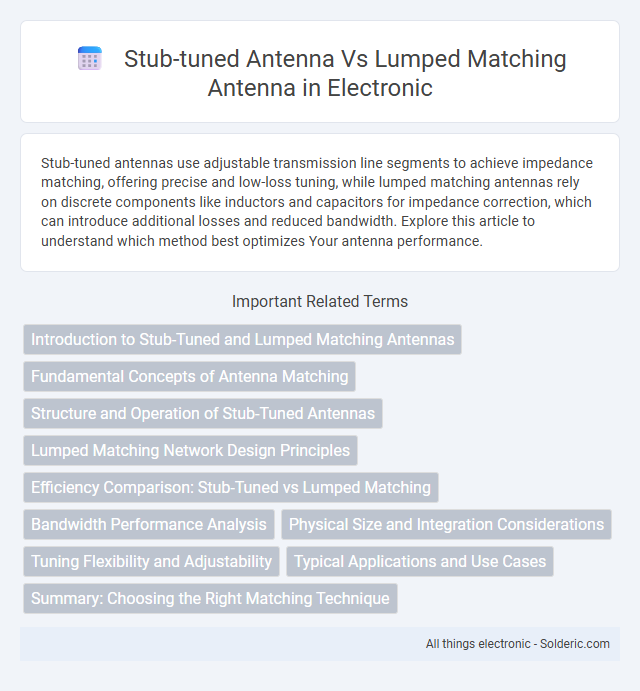Stub-tuned antennas use adjustable transmission line segments to achieve impedance matching, offering precise and low-loss tuning, while lumped matching antennas rely on discrete components like inductors and capacitors for impedance correction, which can introduce additional losses and reduced bandwidth. Explore this article to understand which method best optimizes Your antenna performance.
Comparison Table
| Feature | Stub-Tuned Antenna | Lumped Matching Antenna |
|---|---|---|
| Matching Technique | Uses transmission line stubs for impedance matching | Uses discrete lumped elements (capacitors, inductors) |
| Bandwidth | Generally wider bandwidth due to distributed elements | Narrower bandwidth limited by lumped element Q-factor |
| Losses | Lower insertion loss; less resistive loss | Higher loss due to series resistance in lumped components |
| Size | Typically larger due to transmission line length | More compact due to small lumped components |
| Complexity | Simple to design at microwave frequencies | Requires careful selection of precise components |
| Tuning Flexibility | Fixed tuning once fabricated | Easily tunable by adjusting lumped element values |
| Typical Applications | High-frequency (GHz) antennas in RF circuits | Compact antenna matching in portable devices |
Introduction to Stub-Tuned and Lumped Matching Antennas
Stub-tuned antennas utilize short-circuited or open-circuited transmission line sections to achieve impedance matching by creating reactive elements that cancel out undesired reactance. Lumped matching antennas employ discrete components such as capacitors, inductors, or transformers to adjust the input impedance for maximizing power transfer and minimizing reflection. Both techniques optimize antenna performance by tailoring impedance characteristics but differ in implementation, frequency range, and physical size constraints.
Fundamental Concepts of Antenna Matching
Stub-tuned antennas use transmission line stubs to cancel out reactive components, achieving impedance matching by adjusting stub length and placement precisely. Lumped matching antennas rely on discrete components such as capacitors and inductors to create an equivalent matching network, providing flexibility in miniaturized or integrated designs. Understanding these fundamental concepts helps optimize Your antenna system for maximum power transfer and minimal signal reflection.
Structure and Operation of Stub-Tuned Antennas
Stub-tuned antennas use short-circuited or open-circuited transmission line sections, called stubs, strategically placed along the antenna feedline to create reactive components for impedance matching. These stubs alter the antenna's input impedance by introducing inductive or capacitive reactance, enabling efficient power transfer and improved bandwidth without additional lumped components. Your antenna system benefits from simpler fabrication and minimal insertion loss compared to lumped matching networks involving discrete inductors and capacitors.
Lumped Matching Network Design Principles
Lumped matching antenna networks utilize discrete inductors and capacitors to achieve impedance matching by precisely adjusting reactance components, enabling efficient power transfer between the antenna and transmission line. Their design principles rely on calculating the required reactive elements using Smith charts or impedance parameters to transform complex load impedances to the desired reference impedance, typically 50 ohms. This approach offers compactness and tunability but may introduce losses and bandwidth limitations compared to distributed, stub-based tuning techniques.
Efficiency Comparison: Stub-Tuned vs Lumped Matching
Stub-tuned antennas typically exhibit higher efficiency due to lower resistive losses and improved Q-factor compared to lumped matching antennas, which often rely on discrete components introducing parasitic elements and additional loss. The distributed nature of stub tuning minimizes insertion loss, enhancing power transfer and radiation efficiency, especially at high frequencies. Lumped matching circuits, while compact and versatile, may suffer from reduced efficiency in wideband applications due to component non-idealities and limited quality factors.
Bandwidth Performance Analysis
Stub-tuned antennas demonstrate superior bandwidth performance due to their distributed reactive elements, enabling wider impedance matching ranges over frequency variations compared to lumped matching antennas. Lumped matching antennas rely on discrete components such as inductors and capacitors, which introduce higher losses and narrower bandwidths, limiting their efficacy in wideband applications. Consequently, stub-tuned designs are preferred in scenarios requiring robust and stable impedance matching across broader frequency bands.
Physical Size and Integration Considerations
Stub-tuned antennas offer larger physical footprints due to the transmission line sections used for tuning, making them less suitable for compact, integrated designs. Lumped matching antennas utilize discrete components like inductors and capacitors, significantly reducing the antenna size and enhancing on-chip integration potential. The choice between stub-tuned and lumped matching antennas heavily depends on space constraints and the desired level of integration in RF systems.
Tuning Flexibility and Adjustability
Stub-tuned antennas offer greater tuning flexibility by allowing precise adjustments through altering the length or position of the stub, providing better control over the antenna's impedance matching. Lumped matching antennas rely on discrete components like inductors and capacitors, which provide fixed values that limit real-time adjustability without component replacement. Your choice depends on whether you prioritize continuous tuning adaptability or a simpler, compact design with predefined matching.
Typical Applications and Use Cases
Stub-tuned antennas are widely used in high-frequency applications such as microwave communication systems and radar, where precise impedance matching and minimal insertion loss are critical. Lumped matching antennas are ideal for compact, low-frequency devices like mobile phones and IoT sensors, offering size reduction and easy integration into printed circuit boards. Your choice depends on factors like frequency range, size constraints, and performance requirements in the intended application.
Summary: Choosing the Right Matching Technique
Stub-tuned antennas offer precise impedance matching with adjustable reactance using transmission line stubs, making them ideal for high-frequency and narrowband applications. Lumped matching antennas utilize discrete components like capacitors and inductors, providing compact size and flexibility for low-frequency or broadband designs. Your choice depends on factors such as operating frequency, bandwidth requirements, available space, and complexity, ensuring optimal antenna performance for the specific application.
stub-tuned antenna vs lumped matching antenna Infographic

 solderic.com
solderic.com